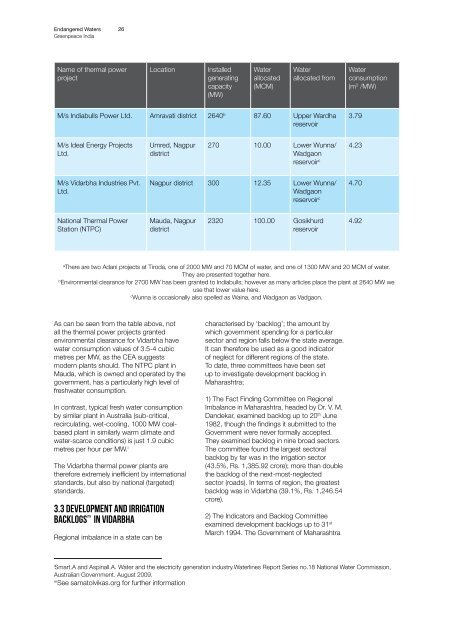Endangered Waters - Greenpeace
Endangered Waters - Greenpeace
Endangered Waters - Greenpeace
Create successful ePaper yourself
Turn your PDF publications into a flip-book with our unique Google optimized e-Paper software.
<strong>Endangered</strong> <strong>Waters</strong><br />
<strong>Greenpeace</strong> India<br />
26<br />
Name of thermal power<br />
project<br />
Location<br />
Installed<br />
generating<br />
capacity<br />
(MW)<br />
Water<br />
allocated<br />
(MCM)<br />
Water<br />
allocated from<br />
Water<br />
consumption<br />
(m 3 /MW)<br />
M/s Indiabulls Power Ltd. Amravati district 2640 b 87.60 Upper Wardha<br />
reservoir<br />
3.79<br />
M/s Ideal Energy Projects<br />
Ltd.<br />
Umred, Nagpur<br />
district<br />
270 10.00 Lower Wunna/ 4.23<br />
Wadgaon<br />
reservoir c<br />
M/s Vidarbha Industries Pvt.<br />
Ltd.<br />
Nagpur district 300 12.35 Lower Wunna/ 4.70<br />
Wadgaon<br />
reservoir c<br />
National Thermal Power<br />
Station (NTPC)<br />
Mauda, Nagpur<br />
district<br />
2320 100.00 Gosikhurd<br />
reservoir<br />
4.92<br />
a<br />
There are two Adani projects at Tiroda, one of 2000 MW and 70 MCM of water, and one of 1300 MW and 20 MCM of water.<br />
They are presented together here.<br />
b<br />
Environmental clearance for 2700 MW has been granted to Indiabulls; however as many articles place the plant at 2640 MW we<br />
use that lower value here.<br />
c<br />
Wunna is occasionally also spelled as Waina, and Wadgaon as Vadgaon.<br />
As can be seen from the table above, not<br />
all the thermal power projects granted<br />
environmental clearance for Vidarbha have<br />
water consumption values of 3.5-4 cubic<br />
metres per MW, as the CEA suggests<br />
modern plants should. The NTPC plant in<br />
Mauda, which is owned and operated by the<br />
government, has a particularly high level of<br />
freshwater consumption.<br />
In contrast, typical fresh water consumption<br />
by similar plant in Australia (sub-critical,<br />
recirculating, wet-cooling, 1000 MW coalbased<br />
plant in similarly warm climate and<br />
water-scarce conditions) is just 1.9 cubic<br />
metres per hour per MW. l<br />
The Vidarbha thermal power plants are<br />
therefore extremely inefficient by international<br />
standards, but also by national (targeted)<br />
standards.<br />
3.3 Development and irrigation<br />
m<br />
backlogs in Vidarbha<br />
Regional imbalance in a state can be<br />
characterised by ‘backlog’; the amount by<br />
which government spending for a particular<br />
sector and region falls below the state average.<br />
It can therefore be used as a good indicator<br />
of neglect for different regions of the state.<br />
To date, three committees have been set<br />
up to investigate development backlog in<br />
Maharashtra;<br />
1) The Fact Finding Committee on Regional<br />
Imbalance in Maharashtra, headed by Dr. V. M.<br />
Dandekar, examined backlog up to 20 th June<br />
1982, though the findings it submitted to the<br />
Government were never formally accepted.<br />
They examined backlog in nine broad sectors.<br />
The committee found the largest sectoral<br />
backlog by far was in the irrigation sector<br />
(43.5%, Rs. 1,385.92 crore); more than double<br />
the backlog of the next-most-neglected<br />
sector (roads). In terms of region, the greatest<br />
backlog was in Vidarbha (39.1%, Rs. 1,246.54<br />
crore).<br />
2) The Indicators and Backlog Committee<br />
examined development backlogs up to 31 st<br />
March 1994. The Government of Maharashtra<br />
l<br />
Smart.A and Aspinall.A. Water and the electricity generation industry.Waterlines Report Series no.18 National Water Commission,<br />
Australian Government. August 2009.<br />
m<br />
See samatolvikas.org for further information

















